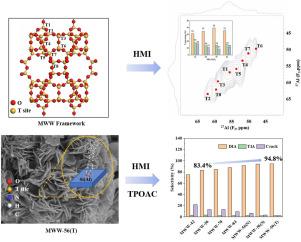The growth mechanism and application in isoamylene oligomerization of MCM-22 zeolite
IF 4.7
3区 材料科学
Q1 CHEMISTRY, APPLIED
引用次数: 0
Abstract
MCM-22 zeolite synthesized by utilizing the hexamethyleneimine as the organic structure directing agent has a wide range of applications. For the growth mechanism of the typical sample, on the macro level, XRD, FT-IR, and SEM are used to confirm the epitaxial growth of the intercalation structure. On the micro level, eight different T sites of the zeolite are completely distinguished as well as the guidance of hexamethyleneimine on T1, T2, T3 and T5 sites has been demonstrated through DFT calculation and solid-state nuclear magnetic resonance. A series of MCM-22 zeolites display the good catalytic stability and dimerization selectivity. The synergy of hexamethyleneimine and amphiphilic organosilane optimizates the mesopore and acidity of the sample effectively, which makes the selectivity and yield of dimerization product exceed 94.8 % and 85.0 % after 12 h respectively. At the same time, the carbon deposition decreases from 3.38 % to 3.13 %. This work provides a theoretical basis for the growth mechanism and application in olefin oligomerization of MCM-22 zeolite.

MCM-22沸石的生长机理及其在异戊烯低聚反应中的应用
以六亚胺为有机结构导向剂合成的MCM-22分子筛具有广泛的应用前景。对于典型样品的生长机理,在宏观层面上,通过XRD、FT-IR、SEM等手段证实了插层结构的外延生长。在微观层面上,完全区分了沸石的8个不同的T位,并通过DFT计算和固态核磁共振证明了六亚胺对T1、T2、T3和T5位的引导作用。一系列的MCM-22分子筛表现出良好的催化稳定性和二聚化选择性。六亚亚胺和两亲性有机硅烷的协同作用有效地优化了样品的介孔和酸度,使二聚化产物的选择性和收率分别超过94.8%和85.0%。同时,碳沉积由3.38%降低到3.13%。本研究为MCM-22分子筛的生长机理及其在烯烃低聚反应中的应用提供了理论依据。
本文章由计算机程序翻译,如有差异,请以英文原文为准。
求助全文
约1分钟内获得全文
求助全文
来源期刊

Microporous and Mesoporous Materials
化学-材料科学:综合
CiteScore
10.70
自引率
5.80%
发文量
649
审稿时长
26 days
期刊介绍:
Microporous and Mesoporous Materials covers novel and significant aspects of porous solids classified as either microporous (pore size up to 2 nm) or mesoporous (pore size 2 to 50 nm). The porosity should have a specific impact on the material properties or application. Typical examples are zeolites and zeolite-like materials, pillared materials, clathrasils and clathrates, carbon molecular sieves, ordered mesoporous materials, organic/inorganic porous hybrid materials, or porous metal oxides. Both natural and synthetic porous materials are within the scope of the journal.
Topics which are particularly of interest include:
All aspects of natural microporous and mesoporous solids
The synthesis of crystalline or amorphous porous materials
The physico-chemical characterization of microporous and mesoporous solids, especially spectroscopic and microscopic
The modification of microporous and mesoporous solids, for example by ion exchange or solid-state reactions
All topics related to diffusion of mobile species in the pores of microporous and mesoporous materials
Adsorption (and other separation techniques) using microporous or mesoporous adsorbents
Catalysis by microporous and mesoporous materials
Host/guest interactions
Theoretical chemistry and modelling of host/guest interactions
All topics related to the application of microporous and mesoporous materials in industrial catalysis, separation technology, environmental protection, electrochemistry, membranes, sensors, optical devices, etc.
 求助内容:
求助内容: 应助结果提醒方式:
应助结果提醒方式:


